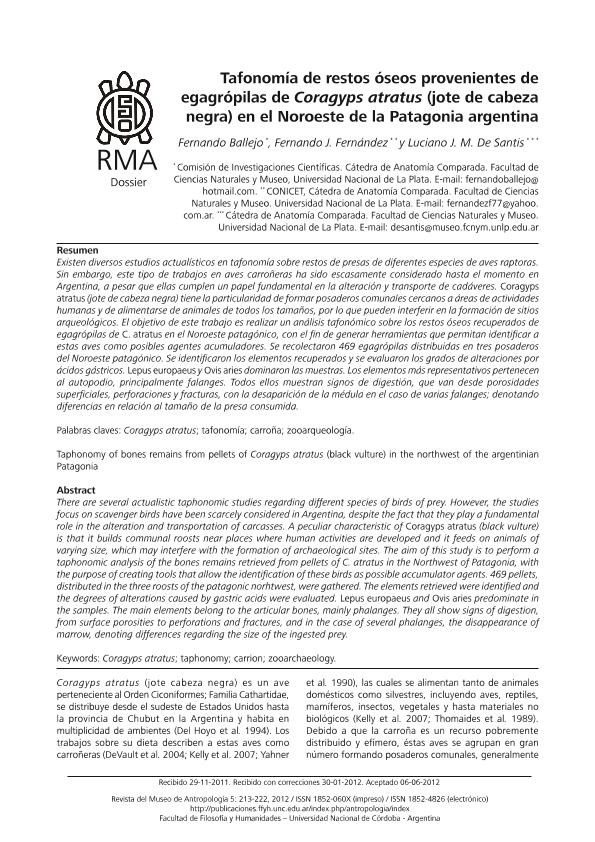Artículo
Existen diversos estudios actualísticos en tafonomía sobre diferentes especies de aves de presa. Sin embargo, este tipo de trabajos en aves carroñeras no había sido considerado hasta el momento en Argentina, a pesar que ellas cumplen un papel fundamental en la alteración y transporte de cadáveres. Coragyps atratus (jote de cabeza negra) tiene la particularidad de formar posaderos comunales cercanos a áreas de actividades humanas y de alimentarse de animales de todos los tamaños, por lo que pueden interferir en la formación de sitios arqueológicos. El objetivo de este trabajo es realizar un análisis tafonómico sobre los restos óseos recuperados de egagrópilas de C. atratus en el noroeste patagónico, con el fin generar herramientas que permitan identificar a estas aves como posibles agentes acumuladores. Se recolectaron 469 egagrópilas distribuidas en tres posaderos del Noroeste patagónico. Se identificaron los elementos recuperados y se evaluaron los grados de alteraciones por ácidos gástricos. Lepus europaeus y Ovis aries dominaron las muestras. Los elementos más representativos pertenecen al autopodio, principalmente falanges. Todos ellos muestran signos de digestión, que van desde porosidades superficiales, perforaciones y fracturas, con la desaparición de la médula en el caso de varias falanges; denotando diferencias en relación al tamaño de la presa consumida. There are several actualistic taphonomic studies regarding different species of birds of prey. However, the studies focus on scavenger birds have been scarcely considered in Argentina, despite the fact that they play a fundamental role in the alteration and transportation of carcasses. A peculiar characteristic of Coragyps atratus (black vulture) is that it builds communal roosts near places where human activities are developed and it feeds on animals of varying size, which may interfere with the formation of archaeological sites. The aim of this study is to perform a taphonomic analysis of the bones remains retrieved from pellets of C. atratus in the Northwest of Patagonia, with the purpose of creating tools that allow the identification of these birds as possible accumulator agents. 469 pellets, distributed in the three roosts of the patagonic norhtwest, were gathered. The elements retrieved were identified and the degrees of alterations caused by gastric acids were evaluated. Lepus europaeus and Ovis aries predominate in the samples. The main elements belong to the articular bones, mainly phalanges. They all show signs of digestion, from surface porosities to perforations and fractures, and in the case of several phalanges, the disappearance of marrow, denoting differences regarding the size of the ingested prey.
Tafonomía de restos óseos acumulados por Coragyps atratus (jote de cabeza negra) en el Noroeste de la Patagonia Argentina
Título:
Taphonomy of bones remains from pellets of Coragyps atratus (black vulture) in the northwest of the argentinian Patagonia
Fecha de publicación:
02/2012
Editorial:
Universidad Nacional de Córdoba. Facultad de Filosofía y Humanidades. Museo de Antropología
Revista:
Revista del Museo de Antropología
ISSN:
1852-060X
Idioma:
Español
Tipo de recurso:
Artículo publicado
Clasificación temática:
Resumen
Palabras clave:
CORAGYPS ATRATUS
,
TAFONOMÍA
,
CARROÑA
,
ZOOARQUEOLOGÍA
Archivos asociados
Licencia
Identificadores
Colecciones
Articulos(CCT - LA PLATA)
Articulos de CTRO.CIENTIFICO TECNOL.CONICET - LA PLATA
Articulos de CTRO.CIENTIFICO TECNOL.CONICET - LA PLATA
Citación
Ballejo, Fernando; Fernández, Fernando Julián; De Santis, Luciano J. M.; Tafonomía de restos óseos acumulados por Coragyps atratus (jote de cabeza negra) en el Noroeste de la Patagonia Argentina; Universidad Nacional de Córdoba. Facultad de Filosofía y Humanidades. Museo de Antropología ; Revista del Museo de Antropología; 5; 1; 2-2012; 213-222
Compartir




